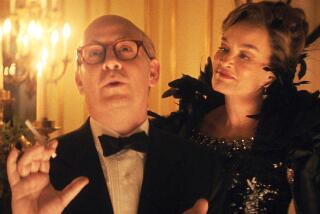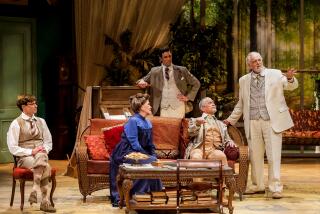BOOK REVIEW : A High-Handed Portrayal of Playwright : BERNARD SHAW The Lure of Fantasy Vol. 3<i> by Michael Holroyd</i> Random House $27.50, 544 pages
Bringing out the third and final volume in his life of George Bernard Shaw, Michael Holroyd has completed an extraordinary labor of 15 years. In straight fact, it is not quite the last volume, nor is the labor quite complete. In due course, steaming after this tripartite armada like a supply tender, we will have a book containing the 10,000 notes that Holroyd believes would have marred his biographical flow.
It is quite as logical and probably as unworkable as any of the subject’s own schemes. Shaw steadily invented more sensible arrangements for the world and regretted, though he was never downcast or discouraged, when the world neglected to adopt them.
A year or so from now, perhaps, Shaw devotees will line up at the bookstores to demand their footnotes, and perhaps not. And did we have to wait to the end of this immense though rewarding slog for at least some of the 10,000 shoes that might have helped the walking?
Just as anyone who looks Medusa in the face turns to stone, anyone who gets involved with Shaw is likely to turn into a flying Shavian paradox. Shaw not only manipulated his biographers, as Holroyd hilariously documents, he also tried to turn them into himself.
With Hesketh Pearson, Shaw gave so much generous material that the talented biographer was able to finish his job with great speed. Shaw’s revision--rewriting and interpolating whole sections--took somewhat longer. As a perfectionist, furthermore, he insisted on imitating Pearson’s particular dramatic style. Consequently, Holroyd writes, Pearson “was faced with an intriguing exercise of impersonating someone who was Pearsonifying him.”
Clearly, Holroyd has caught something of a condition. (So, perhaps, have I.) He is almost as gleeful and purposefully high-handed as his subject, and if his excursions are not as telling--and sometimes fall flat--they are remarkably productive.
It was always hard to catch Shaw; it was impossible to hold him. This massive project misses to some extent by its very massiveness, but it catches Shaw more completely and effectively than anyone else has; and if it does not hold him, why, to hold Shaw would be, by definition, to lose him.
The third volume begins at the end of World War I, which Shaw so valiantly and prophetically criticized. It starts off in fact with his trenchant and equally prophetic criticism of the harsh terms of the peace imposed on Germany. Shaw, it sometimes seems, was never wrong; but sometimes he was beside the point, and sometimes that could be disastrous.
His painful apologia for Stalin--Holroyd treats it masterfully and gives a brilliant account of a ludicrous triumphal visit to Moscow--was aimed at the British.
The Irish have been more abused by British complacency than British brutality (not to underrate that ); and Shaw fell into the trap of trying to pierce it by praising the bludgeon of change, when his needle seemed to have accomplished so little for so long. His early commendation of Mussolini and Hitler stemmed from the same kind of exasperation.
It makes depressing reading. Still, Shaw’s desperate means against British chill is almost understandable when we learn that at the start of World War II, the authorities blocked his broadcast blasting Hitler for his treatment of the Jews. “For millions of Americans and some other people, it is the only thing (Hitler) has done right,” Harold Nicolson wrote in a memo to his superiors.
As in the previous volumes, Holroyd swings energetically on a triangular course from the man to the man of action to the man of letters. There is the autumn of his old flames. His passion for Ellen Terry and Mrs. Patrick Campbell resurface as gentle efforts to delay their publication of his correspondence and his ultimately generous concessions. Love might have ended as litigation; in Shaw’s case, it ended as magnanimity.
There is a full and astonishing account of his long pursuit by a rich and effusive young American, Molly Tompkins. Shaw’s love affairs were always like dancing backward; consummation came when he stood still. There is the long constancy of his marriage to the imperious and devoted Charlotte, and there is a wealth of material about his friendships, literary relations, drivers, translators and others.
The main problem with this third volume is the treatment of Shaw as a playwright. Two of the finest plays--”Heartbreak House” and “St. Joan”--provide plenty to write about. So, to a lesser degree, do “The Apple Cart” and “Back to Methuselah.” But besides writing more plays we have heard of than any other modern playwright, Shaw also wrote more that we never did hear of, and rightly.
In dealing with a dozen or so of the windy, wandering late pieces, Holroyd’s methods fail him. He gives pages and pages of plot and thematic summary which, if indeed there is any life left in the plays, manages to bury it.
Next: Judith Freeman reviews “When I Am an Old Woman I Shall Wear Purple: An Anthology of Short Stories and Poetry” (Papier-Mache Press).
More to Read
Sign up for our Book Club newsletter
Get the latest news, events and more from the Los Angeles Times Book Club, and help us get L.A. reading and talking.
You may occasionally receive promotional content from the Los Angeles Times.






